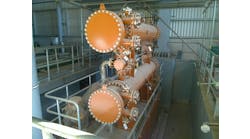Heartening news about U.S. manufacturing is starting to appear in dribs and drabs. While nothing yet points to the American economy rebounding along a wide front, at least it's encouraging to finally see some positive signs. However, according to the latest data provided by the American Chemistry Council for our Economic Snapshot, capacity utilization in the chemical industry remains low — under 68%. Hopefully, we'll soon see a sustained upswing.
During the slump, chemical makers, like other manufacturers, have shed staff and reduced capacity. In some cases, companies have cut output by decreasing throughput. Fortunately, many plants can run reasonably efficiently at relatively low production levels.
In other cases, however, chemical makers have closed plants. "Two major plant dismantling/second-hand equipment vendors recently told me that when the decision to shut down comes most companies remove anything that could present an immediate danger and essentially close the doors and walk away from millions of dollars of equipment," notes Bernie Price in his article "Mothballing Requires More than Idle Thought."
[pullquote]That's irresponsible to the community and the companies themselves.
Dismantling or demolition can make a site safe — usually at a hefty tab, though, even more so when environmental remediation is needed. Abandonment certainly is far cheaper, presuming substantial legal and regulatory costs don't eventually arise.
Many chemical makers traditionally have chosen another option — trying to recoup value from the assets, e.g., by selling the entire operation to another firm, peddling equipment as a package or piecemeal, or mothballing the plant until it can be restarted when demand picks up. Unfortunately, many companies don't devote adequate attention to deactivating assets — and wind up paying a high price.
"Leaving assets 'as is' to deteriorate can make them suitable for scrap in just a matter of months. Yet, it's a fact that unused plant — if properly designed for shutdown and left in fairly good condition — can retain much of its value," stresses Price.
It only should cost 5% or less of Plant Replacement Value (PRV) to reactivate a well-preserved unit, while restarting an inadequately mothballed plant will cost 20+% of PRV and so can subvert its economic viability, he contends.
Yet, many chemical companies still just muddle through. This lax attitude is all the more surprising — if not indefensible — given that the know-how for maintaining deactivated assets isn't new and mysterious. Many of the techniques, materials and equipment have proven their worth for decades.
Price's article provides pointers for mothballing tanks, pressure vessels and pipework; boilers; pumps, engines, compressors and machinery; instruments and controls; motors and generators; auxiliaries, and more.
However, using proper preservation techniques isn't enough, he cautions. Companies must take steps to keep equipment intact. Too many sites condone or at least don't prevent pirating of parts from idled units. This practice can make individual equipment unusable and even undermine restarting entire operations.
Another common lapse is not marking on or near equipment what's been done to preserve it. The reactivating crew usually consists of different people than those who were involved in the mothballing, Price notes. So, they easily can miss that a filter, line blind, internal component or something else has been removed or added unless it's clearly indicated. Such an oversight can have serious consequences at startup.
He also highlights other common mistakes companies make — such as choosing the wrong type of long-term equipment caretakers and failing to keep safety programs and routine audits active.
How plants idle some of their operations draws the ire of Dirk Willard in this month's Field Notes column, "Abandon-in-Place Must End." "Plants sideline equipment and processes for weeks, months or even years. The units are isolated, or perhaps not, and allowed to rust… This approach euphemistically is called 'abandon-in-place.' Regardless of what you call it, it's a poor engineering practice."
Derelict equipment on site can lead to serious accidents, as Willard points out. It also can prompt more insidious issues. For instance, abandoned switchgear may cause ground faults that affect the operating plant's control system. So, operations staff should keep a close eye on idled units. Design engineers also have a responsibility to build in capabilities, e.g., via double-block-and-bleed setups, for likely situations where equipment may require bypassing, he adds.
Economics may dictate the shut down of plants or specific operations. However, deactivation demands care and conscientiousness — otherwise chemical makers not just the affected plants will be derelict.
Mark Rosenzweig is Chemical Processing's Editor in Chief. You can e-mail him at [email protected].

